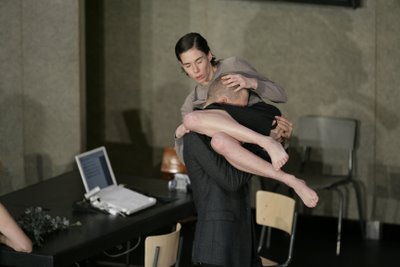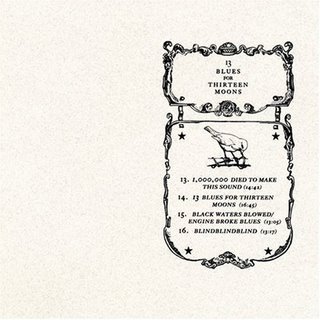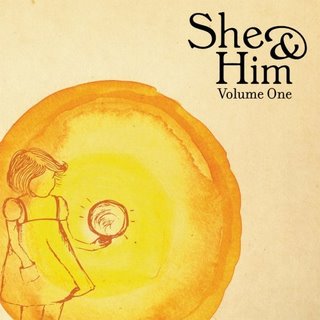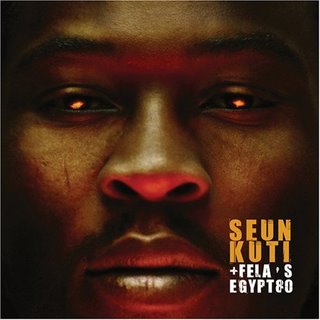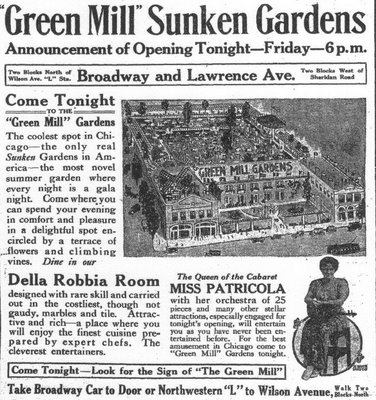Twitter, 11:07 a.m.: I told 1 of the Wrens: Can’t wait for your new CD. His reply: “Neither can we. You got any songs?”
More on that story: The morning after seeing the Wrens play at Prague, I’m in a crowded elevator at the Hilton. The elevator stops at a floor below mine, and the doors open to reveal the four members of the Wrens standing there. There isn’t enough room for all of them to get on, but Kevin Whelan jumps inside, leaving behind his bandmates. “Well, that’s it,” I say to him. “I guess your band’s broken up.” Whelan, who was smiling and acting as if I were an old buddy of his, laughs. I tell him I enjoyed the Wrens show last night
And then comes that exchange I Twittered about above. I add: “You played a couple of news songs last night, didn’t you?” Whelan says: “Yeah. We were just messing around.” Whatever he says, the band is recording a new CD — finally!
 11:45 a.m.: Watching the Lost Brothers. These guys are like a young Irish Everly Bros. Fab voices.
11:45 a.m.: Watching the Lost Brothers. These guys are like a young Irish Everly Bros. Fab voices.
This was over at the Full Irish Breakfast party at B.D. Riley’s. This Liverpool-based Irish duo (according to their sxsw bio, “Mark Mccausland and Oisin leech.- otherwise known as bark and bosh”) sing in sweet harmony. I couldn’t help thinking of the Everly Brothers as I watched them, though their music is on the folkier end of the Everly spectrum. I liked this performance so much that I bought the Lost Brothers’ CD Trails of the Lonely (Parts I & III) from one of the guys as soon as they’d finished singing. The following night, I would run into the Lost Brothers in the audience at another gig. They’d had a fair amount to drink by that point, and when I asked one of them, “You guys aren’t really brothers, are you?” he said, “Sure we are!!!” Here’s the Lost Brothers song “Angry at the Sun.”
I spent the afternoon zipping around to various parties. Over at the SPIN magazine party at Stubbs, New Zealand’s Cut Off Your Hands were sounding loud and aggressive on the Stubbs stage. Not really my thing. When it comes to noisy Kiwis this year, I preferred Bang! Bang! Eche!
 Wildbirds and Peacedrums, a duo from Gothenberg, Sweden, was playing in the Sweden Goes SXSW at Habana Calle 6. I enjoyed this group’s album from last year, Heartcore, which has an unusual mix of atmospheric textures and hard-hitting rhythms. They were an interesting band to see live, with nothing other than drums and vocals. Mariam Wallentin has a brassy voice, and she seemed at times to be throwing it up against the clattering drum patterns from her partner, Andreas Werliin, while adding in some of her own percussion. I’m looking forward to hearing the new album by Wildbirds and Peacedrums, The Snake. Here’s the Wildbirds and Peacedrums song “Doubt/Hope.”
Wildbirds and Peacedrums, a duo from Gothenberg, Sweden, was playing in the Sweden Goes SXSW at Habana Calle 6. I enjoyed this group’s album from last year, Heartcore, which has an unusual mix of atmospheric textures and hard-hitting rhythms. They were an interesting band to see live, with nothing other than drums and vocals. Mariam Wallentin has a brassy voice, and she seemed at times to be throwing it up against the clattering drum patterns from her partner, Andreas Werliin, while adding in some of her own percussion. I’m looking forward to hearing the new album by Wildbirds and Peacedrums, The Snake. Here’s the Wildbirds and Peacedrums song “Doubt/Hope.”
 Twitter, 2:04 p.m.: Pains of Being Pure at Heart is playing at a day party. Sounds stronger than the record, very catchy.
Twitter, 2:04 p.m.: Pains of Being Pure at Heart is playing at a day party. Sounds stronger than the record, very catchy.
The Pains of Being Pure at Heart are one of the indie-rock bands with the most buzz right now. They played at Schubas in Chicago not long ago. Not realizing how much hype they were getting, I failed to get a ticket ahead of time and discovered that night that they’d sold out the show. At SXSW, the Pains seemed to be playing everywhere. I caught them at a party hosted by Pitchfork at Emo’s Jr. Skeptics are calling the Pains “this year’s Vampire Weekend,” to which I say: “No!!!” While I thought Vampire Weekend was last year’s vastly overrated buzz band, the Pains sound nothing like that group.
And while I don’t think the debut CD by the Pains is a masterpiece by any stretch of the imagination, it is pretty enjoyable. And the band was even better as a live out, cranking up the fuzzy feedback and playing those songs with more energy. It’s loud, with a touch of that shoegazer sound, and quite melodic, too. Here’s the Pains of Being Pure at Heart song “Come Saturday.”
See Part 1 of my SXSW photos from March 20.
 2:35 p.m.: Band called Woods sounds like Canned Heat + psychedelic tape effects.
2:35 p.m.: Band called Woods sounds like Canned Heat + psychedelic tape effects.
Not being too familiar with Woods, I wasn’t sure what to expect at this show, which was in Emo’s main room. I checked out their myspace page and loved the songs I heard, but those ones have a female vocalist. And it’s obvious that singer isn’t part of Woods’ current incarnation, which is all-male. One member of Woods knelt on the stage, taking cassette tapes in and out of a machine and singing background vocals into what looked like headphones, adding a layer of weird effects while the rest of the band played jammy roots rock that sounded like something out of the late ’60s or early ’70s.
The group describes its music as: “lysergic & infectiously bent acidfolk pop grooving with motorik percussion, cracked fuzz, unique vocal gush, and burning psych jams… plus enough sweet hooks to get yr next freakout party moving right.” That’s as good of a description as I could come up with, though I’m not sure when my “next freakout party” is going to happen.
 3:59 p.m.: Mt. St. Helens Vietnam Band: looks like a barbershop quartet, sounds like Modest Mouse.
3:59 p.m.: Mt. St. Helens Vietnam Band: looks like a barbershop quartet, sounds like Modest Mouse.
Playing on the most mundane-looking stage at SXSW, the Convention Center’s café, the members of Mt. St. Helen’s Vietnam Band looked around and asked, “What is this place?” (Or words to that effect.) They then ripped through three or so songs with a lot of passion and energy. And yes, they were wearing matching vests. They did look like they were about to harmonize to some songs from the 1890s or something, but their sound is nothing like their look. The Seattle group’s debut CD is on the Dead Oceans label.
I also saw the tail end of the cafe performance by Dublin’s One Day International before Mt. St. Helens Vietnam Band took the stage, but not enough to form much of an opinion.
 4:19 p.m.: The Tallest Man On Earth is not *that* tall. Pretty good folk rock by a guy from Sweden. This was another show at the café. The Tallest Man, a.k.a. Kristian Mattson, performed his solo acoustic songs with an intense look on his face. He really seemed to mean what he was singing.
4:19 p.m.: The Tallest Man On Earth is not *that* tall. Pretty good folk rock by a guy from Sweden. This was another show at the café. The Tallest Man, a.k.a. Kristian Mattson, performed his solo acoustic songs with an intense look on his face. He really seemed to mean what he was singing.
 4:56 p.m.: Taking a break from all the new music for eighties flashback Echo & Bunnymen at SPIN party.
4:56 p.m.: Taking a break from all the new music for eighties flashback Echo & Bunnymen at SPIN party.
Back to Stubbs for the end of the SPIN party. I hadn’t seen Echo and the Bunnymen in more than 20 years. They sounded as good as ever, playing a greatest-hits set with songs including “The Cutter” and “The Killing Moon” alongside a few newer tunes, which fit in pretty well with the classics.
See Part 2 of my SXSW photos from March 20.
The main thing that attracted me to the next party, Sounds of Spain, was the promise of free paella and sangria. I hoped to hear some good music, too, but the singer playing while everyone descended on the food table, the preposterously named Nacho Vegas, sounded to me like a Spaniard trying to sound like a generic American rock musician.
 Twitter, 7:13 p.m.: I’m witnessing a weird pagan ritual, also known as Kansas City band Mythical Beast. Apocalyptic, man.
Twitter, 7:13 p.m.: I’m witnessing a weird pagan ritual, also known as Kansas City band Mythical Beast. Apocalyptic, man.
This was one of my favorite finds of SXSW. I love the fact that weird music like is happening in places all over America, cities like Kansas City, and not just the places that have a reputation for being hip. Wearing a flowing, glittery gold dress, vocalist Corinne belted out her songs with dramatic concentration and booming power, pounding on a big kettle drum with fuzzy-tipped mallets, while guitarists Jeremiah and Aaron played moody riffs that sounded like fragments of a hard-rock band removed from the rest of the band. Corinne’s singing was very impressive, reminding me at times of Grace Slick, P.J. Harvey, Carla Bozulich and Nico. Mythical Beast records on the Language of Stone label run by Greg Weeks of the freaky, psychedelic, folk-rock band Espers, and I can see why Weeks would be interested in Mythical Beast. Here’s the Mythical Beast song “Cycle Circle.”
8:17 p.m.: Watching the Howlies stomping to some garage rock. Pretty good, but they could scuzz it up more.
I had high hopes for the Howlies after hearing their song “Chimera” — a cool ’60s-style garage-rock track. The band was decent as a live act, sounding like an oldies cover band except for the fact that their songs are original, but I was hoping for a little bit more.
9:43 p.m.: London’s brilliant Fanfarlo is rocking an Austin church. Sounds sublime!
This was one of the SXSW shows I was anticipating the most. I saw Fanfarlo last year in a gig at the Wave Rooftop that was marred by delays and technical malfunctions, and ever since then, I had enjoyed listening to the free CD the band handed out of its songs from EP’s released only in Britain. Now, Fanfarlo was playing at Central Presbyterian Church. I liked the idea of seeing this six-piece ensemble, which has strings, horns and extra drums in addition to the usual rock-band lineup, in a church. Alas, the set got off to a bad start with some jarring bass feedback permeating the first song.
The sound got better as the set went on, eventually leading me to Twitter that it sounded “sublime.” A bit of an exaggeration, perhaps, but the songs were great, in any case. The set was far too short for me, but I was able to buy a copy of Fanfarlo’s forthcoming debut CD, Reservoir, at the merch table, and I would get a chance to see Fanfarlo again the next day. Fanfarlo sounds a bit like the Arcade Fire and performs its music with a similar sense of celebration and instrument-swapping. Lead singer Simon Balthazar’s voice reminds me of David Byrne’s. Here’s the Fanfarlo song “Harold T. Wilkins, Or How to Wait for a Very Long Time.”
See Part 3 of my SXSW photos from March 20.
 School of Seven Bells seemed to be getting a fair amount of attention at this year’s SXSW. I caught the trio on the Radio Room Patio and enjoyed what I heard. This is Benjamin Curtis of the Secret Machines (a band I never cared for all that much) playing guitar and drum machines while Italian twin sisters Alejandra and Claudia Deheza (from the band On-Air Library!) join their voices together. They have that lovely sort of harmony that only seems to come out of sibling voices. Here’s the School of Seven Bells song “Half Asleep.” (Hey, why didn’t I Twitter anything about this band?)
School of Seven Bells seemed to be getting a fair amount of attention at this year’s SXSW. I caught the trio on the Radio Room Patio and enjoyed what I heard. This is Benjamin Curtis of the Secret Machines (a band I never cared for all that much) playing guitar and drum machines while Italian twin sisters Alejandra and Claudia Deheza (from the band On-Air Library!) join their voices together. They have that lovely sort of harmony that only seems to come out of sibling voices. Here’s the School of Seven Bells song “Half Asleep.” (Hey, why didn’t I Twitter anything about this band?)
 Twitter, 11:13 p.m.: O Canada, you keep sending up such good bands. Toronto’s Golden Dogs are storming through some great power pop.
Twitter, 11:13 p.m.: O Canada, you keep sending up such good bands. Toronto’s Golden Dogs are storming through some great power pop.
I realize now that the Golden Dogs have played at SXSW for the past four years, and I’ve accumulated four songs by this Toronto band in my iTunes library. But I did not see them until now. What drew me was a cool song called “Lester.” The band sounded great live, something like late ’60s or early ’70s power pop, with alternating male and female vocals. A bit of the New Pornographers, perhaps. On their last song of the night, the Golden Dogs made a smooth segue into the classic guitar chords and drums of the Beatles’ “The End.” (Someone in the crowd shouted, “Punk rock!” at that moment, somewhat incongruously.)
 11:54 p.m.: Now it’s time for a little live Devo. … 12:40 a.m.: After 5 songs in orange safety vests, Devo donned those red flower pot hats. “Whip It.”
11:54 p.m.: Now it’s time for a little live Devo. … 12:40 a.m.: After 5 songs in orange safety vests, Devo donned those red flower pot hats. “Whip It.”
The reunited original members of Devo looked older, but just as nerdy. Wearing those Devo outfits as they played songs from “Whip It” to their cover of “(Can’t Get No) Satisfaction,” they really looked like utility repairmen out on the job. I noticed several geeky fans wearing those red flower-pot hats, er, “energy domes,” which were for sale at the merch counter for $30. Good times.
 I ended the night at the Hideout, the same little theater where I’d begun the evening watching Mythical Beast. The last band of the showcase there was Magic Lantern from Long Beach, Calif. When I was preparing for SXSW by listening to the thousand-plus mp3s posted at www.sxsw.com, I noticed that the Magic Lantern track, “At the Mountains of Madness,” was the longest one in the bunch, clocking in at 14 minutes and 51 seconds. While I skipped through some of the other songs after hearing 30 seconds, I listened to all of this one — a heavy psychedelic jam. The band was great live, too, playing thunderous riffs with a mesmerizing sense of repetition.
I ended the night at the Hideout, the same little theater where I’d begun the evening watching Mythical Beast. The last band of the showcase there was Magic Lantern from Long Beach, Calif. When I was preparing for SXSW by listening to the thousand-plus mp3s posted at www.sxsw.com, I noticed that the Magic Lantern track, “At the Mountains of Madness,” was the longest one in the bunch, clocking in at 14 minutes and 51 seconds. While I skipped through some of the other songs after hearing 30 seconds, I listened to all of this one — a heavy psychedelic jam. The band was great live, too, playing thunderous riffs with a mesmerizing sense of repetition.
































